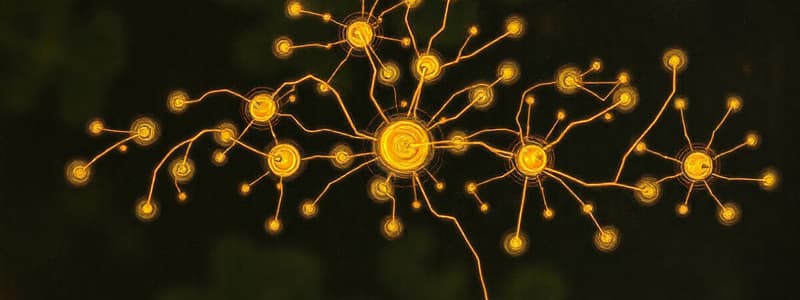Podcast
Questions and Answers
What is a primary reason some cells cannot perform respiration?
What is a primary reason some cells cannot perform respiration?
- They are unable to utilize glucose.
- They have too many electron carriers.
- They lack a sufficient final electron acceptor. (correct)
- They are excessively reliant on fermentation.
Which type of fermentation only produces lactic acid?
Which type of fermentation only produces lactic acid?
- Heterolactic Fermentation
- Ethanol Fermentation
- Alcohol Fermentation
- Homolactic Fermentation (correct)
How many ATP molecules are produced during glycolysis alone in fermentation?
How many ATP molecules are produced during glycolysis alone in fermentation?
- 3 ATP
- 1 ATP
- 2 ATP (correct)
- 4 ATP
Which of the following roles does lactic acid bacteria (LAB) NOT play?
Which of the following roles does lactic acid bacteria (LAB) NOT play?
What kind of fermentation produces lactic acid, ethanol, acetic acid, and CO2?
What kind of fermentation produces lactic acid, ethanol, acetic acid, and CO2?
What is a characteristic of prokaryotes that cannot respire at all?
What is a characteristic of prokaryotes that cannot respire at all?
Which of the following reactions represents alcohol fermentation?
Which of the following reactions represents alcohol fermentation?
What conditions enable facultative prokaryotes to switch to respiration?
What conditions enable facultative prokaryotes to switch to respiration?
Flashcards are hidden until you start studying
Study Notes
Respiration Limitations
- Cells may struggle with respiration due to a lack of the required inorganic final electron acceptors.
- Genetic limitations can prevent cells from synthesizing essential complexes and electron carriers needed for the electron transport system.
- Cells may also lack genes for enzymes necessary for the Krebs cycle, affecting their respiratory capabilities.
- The inability to utilize an electron acceptor can depend on environmental conditions; genetic limitations are permanent.
Prokaryotic Respiration
- Some prokaryotes, such as Streptococcus, are incapable of respiration even in the presence of oxygen.
- Facultative prokaryotes can switch to respiration when conditions permit, allowing for increased ATP production from glucose.
Glycolysis and NADH Recycling
- In the absence of respiration, NADH must be converted back to NAD+ to sustain glycolysis, which is the sole method for ATP production under these circumstances.
Fermentation as an Alternative
- Fermentation uses organic molecules like pyruvate as final electron acceptors, bypassing the electron transport system.
- This process yields only up to 2 ATP per glucose through glycolysis, making it less efficient than respiration.
Microbial Fermentation Applications
- Fermentation is significant in producing food, pharmaceuticals, and for microbial identification.
Lactic Acid Fermentation
- Occurs in low-oxygen environments and involves organisms like yogurt bacteria and human muscle cells.
- Chemical Reaction: Pyruvate + NADH ↔ Lactic Acid + NAD+.
Lactic Acid Bacteria (LAB)
- Includes species like Lactobacillus, Leuconostoc, and Streptococcus, crucial for yogurt and cheese production by coagulating milk proteins through acidity.
- Two types of fermentation:
- Homolactic Fermentation: Produces only lactic acid (e.g., Lactobacillus delbrueckii).
- Heterolactic Fermentation: Generates lactic acid, ethanol, acetic acid, and CO2 (e.g., Leuconostoc mesenteroides used in pickles and sauerkraut).
Medical Importance of LAB
- LAB help inhibit pathogen growth by creating a low pH environment in the body.
- Crucial for maintaining vaginal health, as imbalances can lead to yeast infections.
- LAB are essential components of probiotics, supporting gastrointestinal health.
Alcohol Fermentation
- This process converts pyruvate into ethanol.
- Chemical Reactions:
- Pyruvate → Acetaldehyde + CO2 (via pyruvate decarboxylase).
- Acetaldehyde + NADH → Ethanol + NAD+ (via alcohol dehydrogenase).
- Alcohol fermentation is utilized in the production of alcoholic beverages and baking, with CO2 contributing to the rise of bread.
- It is also important for biofuel generation from plant materials.
Studying That Suits You
Use AI to generate personalized quizzes and flashcards to suit your learning preferences.




